Tips and Tricks for Drilling a Hole in Stucco

Drilling a hole in stucco can be a daunting task, but with the right tools and techniques, it can be accomplished easily and without damaging the surface. Whether you need to hang a picture frame, install outdoor lights, or mount a security camera, knowing how to drill a hole in stucco is an essential skill for any homeowner or DIY enthusiast.
First and foremost, it is important to use the correct type of drill bit for drilling into stucco. A masonry bit, specifically designed for drilling into concrete and masonry surfaces, is the best choice. These bits are made from hardened steel and have a carbide tip to ensure durability and efficient drilling.
Before you begin drilling, it is crucial to locate the area where you want to drill the hole and ensure there are no electrical or plumbing lines behind the stucco. Using a stud finder or a digital multi-meter with a stud-finding function can help you identify any potential obstacles before drilling.
When drilling into stucco, it is important to start with a pilot hole. This small hole acts as a guide for the larger drill bit and helps prevent the stucco from chipping or cracking. To create a pilot hole, use a smaller masonry bit and apply light pressure while drilling. Once the pilot hole is made, you can switch to a larger drill bit to create the desired size hole.
It is recommended to drill at a slow speed to prevent overheating the drill bit and to use a hammer function on the drill if necessary. The hammer function will help break through the stucco and ensure a clean and precise hole. It is also important to periodically remove the drill bit and clear out any dust or debris to maintain optimal drilling performance.
Choosing the Right Drill and Bit
When it comes to drilling a hole in stucco, selecting the right type of drill and bit is crucial. The wrong tools can result in damaged stucco or a hole that isn’t properly sized or shaped. Here are some tips to help you choose the right drill and bit for the job:
1. Drill Selection
- Choose a drill that is powerful enough to handle drilling through stucco. A corded drill with variable speed settings is typically a good option.
- Consider using a hammer drill for larger holes or tougher stucco surfaces. Hammer drills apply a pounding action to the bit to help break through the hard surface of the stucco.
2. Bit Selection
- Use a masonry bit specifically designed for drilling into stucco or concrete. These bits have a carbide tip that is capable of penetrating the tough stucco surface.
- Select a bit size that matches the diameter of the hole you need to drill. It’s important to choose the right size to ensure the stability and integrity of the hole.
- Consider using a depth stop collar or tape to help control the depth of your hole. This will prevent you from drilling too far into the stucco and damaging the underlying structure.
3. Safety Precautions
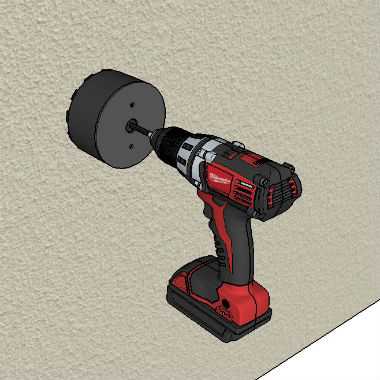
Before drilling into stucco, it’s important to wear safety goggles to protect your eyes from any flying debris. Additionally, make sure to secure the workpiece and use steady pressure while drilling to prevent any slipping or accidents.
By choosing the right drill and bit, you can ensure a successful drilling experience when working with stucco. Remember to follow safety guidelines and take your time to achieve the best results.
Preparing the Stucco Surface
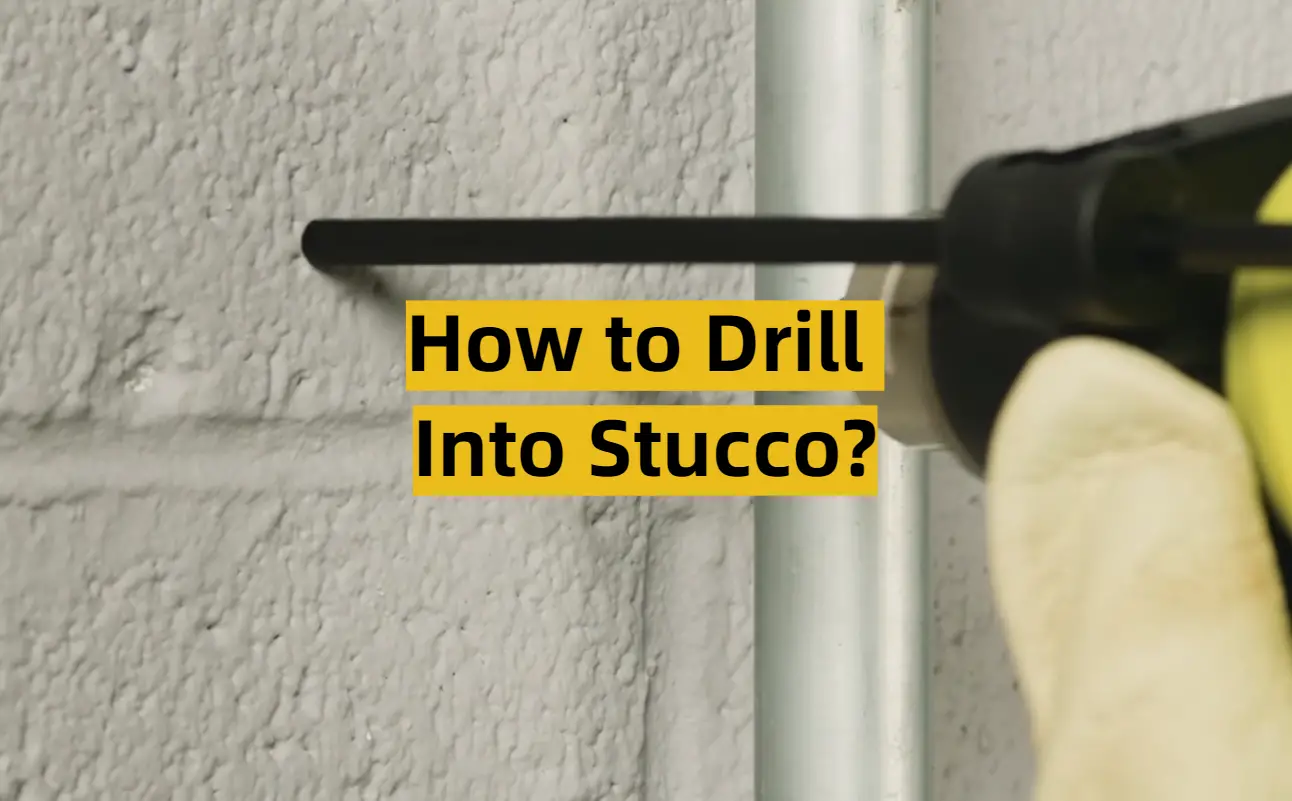
- Inspect the stucco surface to ensure it is in good condition. Look for any cracks, holes, or other damage.
- Repair any damage to the stucco before drilling a hole. Use a stucco repair compound and follow the manufacturer’s instructions.
- Clean the surface of the stucco before drilling. Remove any dirt, debris, or loose stucco using a brush or broom.
- Use a piece of painter’s tape to mark the exact spot where you want to drill the hole. This will help guide the drill bit and prevent it from wandering.
- Measure the depth of the hole you need to drill. Use a tape measure or ruler to determine the desired depth.
- Choose the right type of drill bit for stucco. A masonry drill bit is recommended for drilling into stucco as it is designed to handle the hard material.
- Attach the drill bit to your drill and adjust the speed settings according to the manufacturer’s instructions.
- Hold the drill perpendicular to the stucco surface and apply firm, but gentle pressure as you begin drilling.
- Drill slowly and steadily, allowing the drill bit to do the work. Applying too much force or drilling too quickly can cause the stucco to crack or chip.
- Stop drilling periodically to clear away any debris from the hole. You can use a vacuum or blow away the debris with a burst of compressed air.
- Once you have drilled the hole to the desired depth, carefully remove the drill bit from the hole.
- Inspect the hole to ensure it is clean and free of debris. If necessary, use a brush or compressed air to remove any remaining debris.
Marking the Spot
Before you start drilling a hole in stucco, it’s important to mark the spot where you want to place the hole. This will help ensure that you drill in the correct location and avoid any unnecessary damage to the stucco surface.
To mark the spot, follow these steps:
- Measure and mark the desired location with a pencil or marking tool. Use a tape measure or ruler to ensure accurate measurements.
- Double-check the placement to make sure it aligns with your desired outcome. Consider factors such as the size of the hole, the distance from existing holes or edges, and any structural considerations.
- If necessary, use a level to ensure that the mark is straight and aligned with the surrounding surface. This is especially important if you’re drilling multiple holes in a straight line or if the hole needs to be perfectly vertical or horizontal.
Pro Tip: If you’re drilling into stucco on a textured surface, you can use a small piece of masking tape or painter’s tape to mark the spot. This will provide a flat surface for your pencil or marking tool, making it easier to create a clear and precise mark.
Once you’ve marked the spot, you’re ready to move on to the next step: preparing the drill and selecting the appropriate drill bit for the job.
Drilling Techniques for Stucco
1. Use the Right Drill Bit
When drilling into stucco, it’s important to use the correct drill bit. A masonry drill bit is recommended as it is specifically designed for drilling into hard materials like stucco, concrete, and brick. The masonry drill bit has a carbide tip that is able to withstand the tough surface of stucco and provide a clean hole.
2. Mark the Spot
Before drilling, it’s essential to mark the spot where you want to drill the hole. This will help ensure accuracy and prevent any mistakes. Use a pencil or a marker to make a small dot or an “X” on the desired spot. This will serve as a guide when positioning the drill.
3. Start with a Pilot Hole
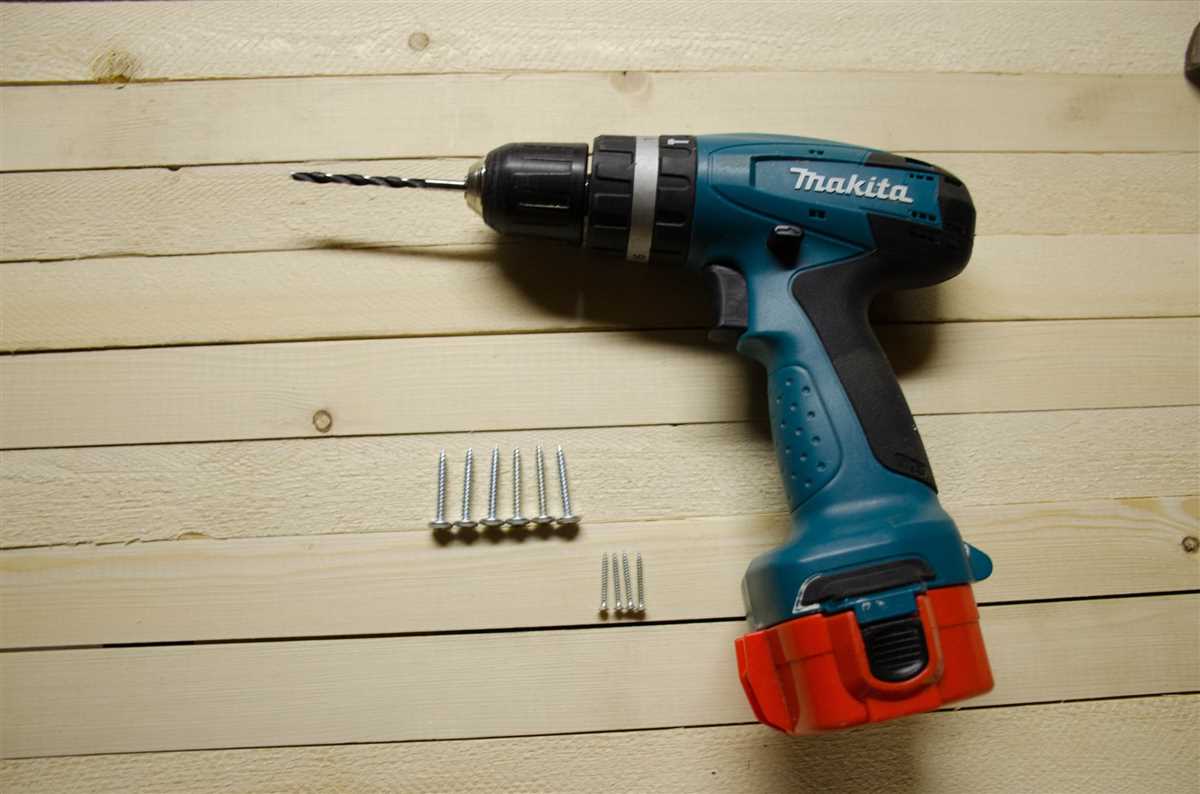
When drilling into stucco, it’s best to start with a pilot hole. A pilot hole is a smaller hole that serves as a guide for the larger drill bit. Use a smaller drill bit, preferably one that is slightly smaller than the final hole size, and drill a small hole at the marked spot. This will help prevent any cracks or damage to the stucco when drilling the final hole.
4. Drill Slowly and with Constant Pressure
When drilling into stucco, it’s important to drill slowly and apply constant pressure. Avoid using excessive force as it can cause damage to the stucco and the drill. Apply steady pressure and let the drill do the work. Drilling too fast or with too much force can result in cracks or chips in the stucco surface.
5. Use a Vacuum or Mask to Control Dust
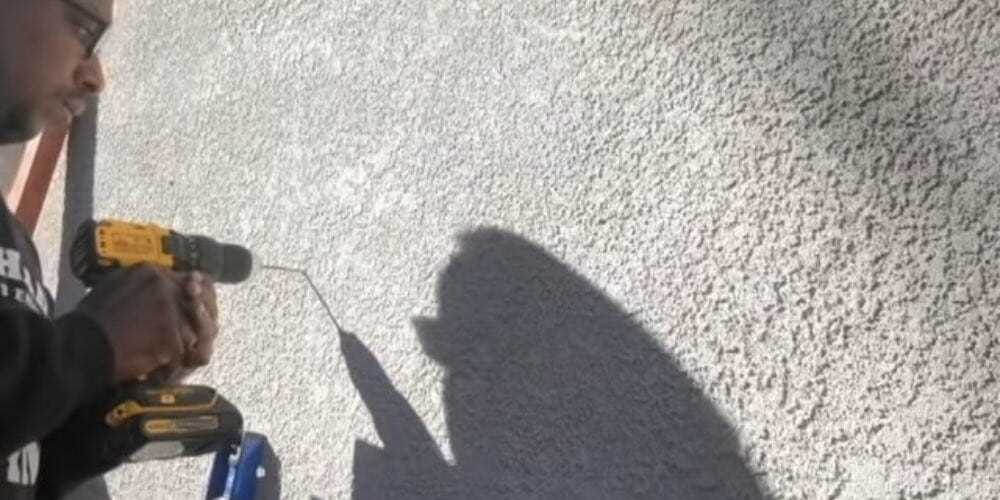
Drilling into stucco can create a lot of dust. To keep the area clean and prevent inhalation of dust particles, use a vacuum or wear a mask. Attach a vacuum hose near the drilling area to suck up the dust as you drill. Alternatively, wear a dust mask to protect your lungs from the fine particles.
6. Secure the Stucco Surface
To prevent the stucco from cracking or chipping during drilling, it’s a good idea to secure the surface. Place a piece of plywood or a small block of wood behind the stucco where you’ll be drilling. This will provide support and prevent the stucco from cracking under pressure.
7. Clean Up the Area
After drilling the hole, clean up the area to remove any dust or debris. Use a brush or a cloth to wipe away the dust from the stucco surface. This will help maintain the appearance of the stucco and ensure a clean installation of any fasteners or anchors.
8. Consider Using Anchors
If you’ll be installing a screw or a fastener in the drilled hole, consider using anchors for added strength and stability. Anchors are small devices that are inserted into the hole before inserting the screw or fastener. They provide extra grip and support for the screw, especially in stucco, which may have a softer backing material.
| Pros | Cons |
|---|---|
|
|
In conclusion, drilling into stucco requires the right drill bit, careful drilling techniques, and attention to detail. By following these tips, you can successfully drill holes in stucco without causing damage or compromising the integrity of the surface.
Avoiding Cracks and Damage
When drilling a hole in stucco, it is important to take precautions to avoid causing cracks or damage to the surface. Here are some tips to help you avoid any mishaps:
- Use the appropriate drill bit: Stucco is a hard, durable material, so it requires a specific type of drill bit. Use a masonry drill bit that is designed for drilling into concrete or stucco. This will help prevent the drill bit from slipping or causing unnecessary damage.
- Mark the drilling area: Before drilling, mark the exact spot where you want to drill the hole. Use a pencil or a piece of removable tape to clearly indicate the drilling point. This will help you stay centered and prevent any accidental slips or off-center holes.
- Start with a smaller pilot hole: If you’re drilling a large hole, it’s a good idea to start with a smaller pilot hole. This will help guide the larger drill bit and reduce the chances of the stucco cracking or chipping. Once the pilot hole is drilled, you can gradually widen it with the larger drill bit.
- Apply gentle and consistent pressure: When drilling into stucco, apply gentle and consistent pressure. Avoid using excessive force, as this can cause the stucco to crack. Let the drill bit do the work and don’t rush the drilling process.
- Keep the drill speed low: Stucco is a delicate material, so it’s important to keep the drill speed low. A high drill speed can generate excessive heat, which can lead to cracks or damage. Set the drill to a low speed setting and take your time to ensure a clean and controlled drilling process.
- Use a vacuum or damp cloth: To minimize dust and debris, consider using a vacuum attachment or holding a damp cloth near the drilling area. This will help prevent the dust from spreading and make cleaning up easier.
- Inspect the drilled hole: After drilling the hole, inspect it carefully for any cracks or damage. If you notice any issues, you may need to patch or repair the stucco. It’s important to address any damage promptly to ensure the integrity of the stucco surface.
- Consider hiring a professional: If you’re uncertain about drilling into stucco or if you have a complex drilling project, it may be best to hire a professional. They have the experience and tools needed to drill into stucco without causing any cracks or damage.
By following these tips and taking your time during the drilling process, you can avoid cracks and damage to the stucco surface. Remember to prioritize safety and consult a professional if needed. Good luck with your drilling project!
Dealing with Metal Mesh Reinforcement
When drilling a hole in stucco that is reinforced with metal mesh, there are a few extra steps you may need to take to ensure a successful and secure installation.
1. Locate the metal mesh reinforcement
Before drilling, it is essential to locate the metal mesh reinforcement behind the stucco surface. You can use a stud finder or tap the surface lightly to identify any areas that sound hollow, indicating the presence of the mesh.
2. Use a masonry drill bit
When drilling through stucco with metal mesh, using a standard drill bit may lead to damaging the mesh or causing the drill bit to become stuck. Instead, use a masonry drill bit specifically designed for drilling through hard materials like stucco and concrete. These bits have a carbide or diamond tip that can easily cut through the stucco without damaging the metal mesh.
3. Drill at a slow speed
To prevent the drill from catching on the metal mesh or causing excessive vibrations, it is important to drill at a slow speed. This will allow the drill bit to cut through the stucco and metal mesh gradually without causing any damage. Applying too much pressure or drilling at high speeds can result in the drill bit getting caught or the stucco cracking around the hole.
4. Clean the hole thoroughly
After drilling the hole, it is crucial to clean out any debris or loose stucco from the hole. This will ensure a secure and seamless installation. Use a small brush or compressed air to remove any loose particles from the hole and around the metal mesh.
5. Use appropriate anchors or screws
When fastening something to stucco with metal mesh reinforcement, it is important to use anchors or screws designed specifically for this purpose. These anchors or screws should be long enough to penetrate through the stucco and securely anchor into the metal mesh behind it. Be sure to follow the manufacturer’s instructions for proper installation.
By following these steps, you can successfully drill a hole in stucco that has metal mesh reinforcement without damaging the mesh or compromising the integrity of the stucco surface.
Sealing and Patching After Drilling
After drilling a hole in stucco, it is important to properly seal and patch the area to ensure a clean and secure finished look. Here are some tips and techniques to help you achieve a professional result:
1. Clean the hole:
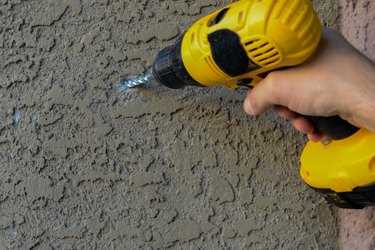
- Use a brush or compressed air to remove any debris, dust, or loose stucco from the hole.
- Wipe the area with a clean, damp cloth to ensure a clean surface for sealing.
2. Apply sealant:
- Choose a high-quality exterior caulk or Sealant specifically designed for stucco surfaces.
- Apply a thin bead of sealant around the edges of the hole, smoothing it with a caulk tool or your finger.
- Make sure to completely cover any gaps or cracks to prevent water infiltration.
3. Patch the hole:
- Use a stucco patching compound that matches the color and texture of your existing stucco.
- Apply the patching compound in layers, using a trowel or putty knife to smooth and level each layer.
- Follow the manufacturer’s instructions for drying and curing times.
- Sand the patched area smooth once it is fully dried.
4. Paint or finish:
- If necessary, prime and paint the patched area to match the surrounding stucco.
- If your stucco has a textured finish, you may need to apply a texture coating to blend the patch with the existing surface.
- Follow the manufacturer’s instructions for proper paint application and drying times.
5. Maintain the patched area:
- Regularly inspect the patched area for any signs of damage or wear.
- If any cracks or gaps appear, reapply sealant or patching compound as necessary.
- Perform routine maintenance on your stucco, such as cleaning and sealing, to prevent future issues.
By following these steps, you can ensure that your drilled holes in stucco are properly sealed and patched, providing a durable and aesthetically pleasing result.
Safety Precautions and Considerations
1. Wear Protective Gear
Before drilling a hole in stucco, it is important to wear the necessary protective gear. This includes safety goggles to protect your eyes from flying debris, gloves to protect your hands, and a dust mask to prevent inhalation of particles.
2. Check for Electrical Wiring
Before drilling into the stucco, ensure that there are no electrical wires or cables behind the area where you plan to drill. Use a stud finder or a wire detector to detect any hidden electrical wiring. Drilling into electrical wiring can be extremely dangerous and may cause electrocution or fires.
3. Use the Appropriate Drill Bits and Tools
Ensure that you have the correct drill bits and tools for drilling into stucco. High-quality masonry drill bits specifically designed for use with stone or brick should be used. These drill bits have a carbide tip that is capable of handling the tough stucco surface.
4. Secure the Stucco Surface
Before drilling, it is essential to ensure that the stucco surface is secure and stable. If there are any loose or flaking areas, they should be repaired before drilling. Loose stucco can chip or crack during drilling, leading to an unstable and unsafe surface.
5. Drill Slowly and Steadily
When drilling into stucco, it is important to exercise caution and drill slowly and steadily. Applying excessive force or drilling at high speeds can cause the drill bit to slip or the stucco to crack or fracture. Take your time and apply even pressure as you drill.
6. Use a Vacuum or Dust Collection System
Drilling into stucco can create a significant amount of dust and debris. To minimize the mess and clean-up afterward, consider using a vacuum or dust collection system. These devices will help capture the dust and debris as you drill, keeping the work area clean and preventing potential hazards.
7. Dispose of Debris Properly
After drilling the hole, make sure to collect and dispose of the debris in a safe and appropriate manner. Do not leave the debris lying around, as it can be a tripping hazard or cause injury to others. Use a brush or vacuum to collect the debris and dispose of it in a designated waste container.
8. Follow Manufacturer’s Instructions
Always follow the manufacturer’s instructions for your specific drilling equipment and tools. This will ensure that you are using them correctly and safely. If you are unsure about any aspect of drilling into stucco, consult the manufacturer’s guidelines or seek professional assistance.
9. Secure the Drill Properly
When drilling into stucco, make sure to hold the drill firmly and securely. A loose or unsteady grip can cause the drill to slip, leading to accidents or injuries. Use both hands to control the drill and maintain stability throughout the drilling process.
10. Keep Children and Pets Away
It is important to keep children and pets away from the work area while drilling into stucco. The process can be noisy, and debris can fly around, posing a risk to their safety. Ensure that the area is clear of any distractions or potential hazards before drilling.
| Safety Precautions |
|---|
| Wear protective gear |
| Check for electrical wiring |
| Use the appropriate drill bits and tools |
| Secure the stucco surface |
| Drill slowly and steadily |
| Use a vacuum or dust collection system |
| Dispose of debris properly |
| Follow manufacturer’s instructions |
| Secure the drill properly |
| Keep children and pets away |
FAQ:
What tools do I need to drill a hole in stucco?
To drill a hole in stucco, you will need a masonry drill bit, a hammer drill, safety goggles, a dust mask, and a vacuum to clean up the dust.
What size drill bit should I use for stucco?
The size of the drill bit you should use for stucco depends on the size of the anchor or screw you plan to use. Typically, a 1/4-inch or 3/8-inch masonry drill bit is suitable for most applications.
How do I protect myself when drilling into stucco?
When drilling into stucco, it is important to protect yourself by wearing safety goggles to protect your eyes and a dust mask to prevent inhaling any dust particles. Additionally, it is best to work in a well-ventilated area and clean up any dust with a vacuum.
Can I use a regular drill to drill into stucco?
It is not recommended to use a regular drill to drill into stucco. Stucco is a tough material, and a regular drill may not have enough power to drill through it. It is best to use a hammer drill, which is specifically designed for drilling into masonry or concrete.
What is the best technique for drilling a hole in stucco?
The best technique for drilling a hole in stucco is to start by marking the spot where you want to drill. Then, use a hammer drill with a masonry drill bit to slowly and carefully drill into the stucco. Apply steady pressure and let the drill do the work. It is important to avoid applying too much pressure or drilling too quickly, as this can cause the stucco to crack.
How do I fill the hole in stucco after drilling?
After drilling a hole in stucco, you can fill the hole with a stucco patching compound. Start by cleaning any dust or debris from the hole, then use a putty knife to apply the stucco patching compound. Smooth the surface with the putty knife and let it dry. Once dry, you can paint over the patch to match the surrounding stucco.
What are some common mistakes to avoid when drilling into stucco?
When drilling into stucco, it is important to avoid common mistakes such as using too much pressure, drilling too quickly, or using the wrong type of drill or drill bit. These mistakes can cause the stucco to crack or the drill to become damaged. It is also important to work in a well-ventilated area and wear the appropriate safety gear to protect yourself.
Video:











